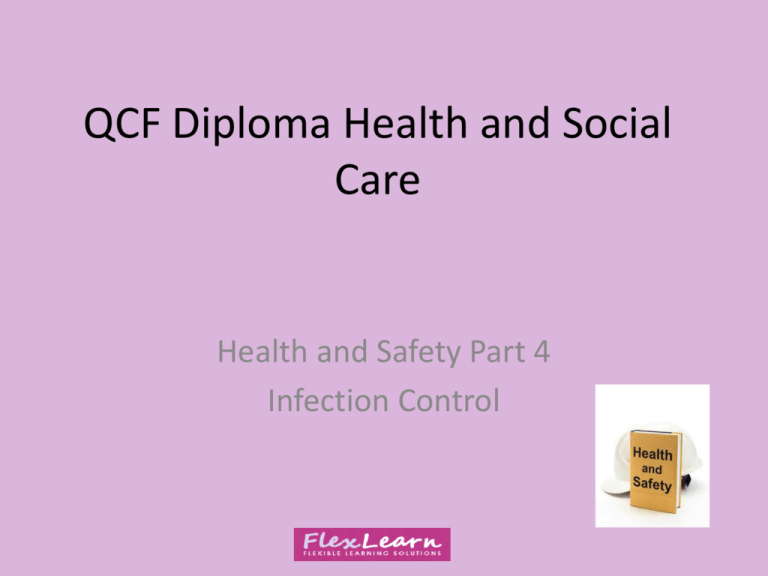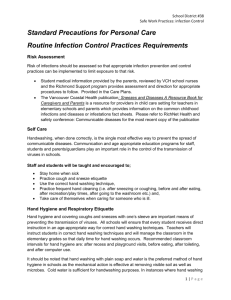Document
advertisement

QCF Diploma Health and Social Care Health and Safety Part 4 Infection Control What we will look at: • Preventing the spread of infection • Effective hand washing Preventing the Spread of Infection • Infection occurs through a chain of events, so the best way to control it is to break the chain. Activity • Describe the precautions you should take in your area of work to prevent the spread of infection. How Infection Spreads • Infection is caused by tiny, harmful germs, known as micro organisms. They are so small they can only be seen through a microscope. Most commonly, these micro-organisms are in the form of bacteria or viruses, but fungi can also be a source of infection. • These micro-organisms cannot travel independently, and need to be transported from place to place and person to person. This process is known both as transmission and cross-infection, and there are two methods by which it takes place: Direct Contact • Direct contact from person to person, through people being in close proximity. This includes sexual contact. which is how sexually transmitted infections (STIs) are spread. Some viruses are passed from a mother to her foetus, via the placenta. Indirect Contact • Indirect contact from person to object and object to another person, for example through two people sharing syringes and needles, which is how drug users risk being infected by HIV and hepatitis. The word 'fomite' is the term used to describe a contaminated object that carries infection. Some examples of common ‘fomites’ are clothing or uniforms worn in some care settings, bedpans, bedclothes and eating utensils. How Infection Enters the Body • Cuts and wounds- The skin provides a protective barrier for the body,but bacteria and viruses can enter the body wherever there are skin breaks or vulnerable areas. • The digestive system, via contaminated food or water, or eating food that is prepared or served with dirty hands or using dirty equipment. Bacteria may also be present in large numbers in food that has not been cooked sufficiently or has been stored at the wrong temperature. • Contaminated needles or equipment can introduce microorganisms into the blood circulation. • Via the placenta, from mother to baby. • From contact with body fluids. • Inhaling droplets of airborne infection, which is how colds and 'flu' are spread. • Genital route, for example, via catheters or through sexual activity. Standard Precautions • Standard precautions means taking the same precautions with every person as if they pose an infection risk to other people, and acting as though you also pose an infection risk to others. The four main elements of universal precautions are: • Create a barrier - between your body and the next person.In the workplace this is achieved by wearing protective clothing (plastic aprons, disposable gloves and less commonly, face masks). • Wash hands - thoroughly and frequently, especially after contact with yours or others' body fluids (using the toilet, for example) before using alcohol gel or putting on disposable gloves. • Clean appropriately - the work environment and any equipment using correct chemicals and methods. • Raise awareness - and educate others about personal and professional responsibility for infection prevention and control. Personal Protective Equipment • It is vital that protective clothing is used appropriately, otherwise the barrier it provides becomes inadequate and infection gets through. Below is the main personal protective equipment: • Disposable gloves - wear to protect your hands from the body fluids of others and to cover any sore skin. In this way you reduce the chance of your hands becoming a means for cross infection. Always change gloves after each activity or they will pose as much risk as your uncovered hands. Some people are allergic to certain types of disposable gloves. for example latex. If this is the case. consult occupational health or your nearest infection protection and control team. • Disposable apron - the shiny surface makes it very difficult for microbes to stick and stay long enough to multiply. Change your apron between tasks and people. and replace it if it becomes ripped. • Always dispose of any protective clothing as clinical waste. Activity • Identify the infection control guidelines to follow for each of the following: • Dealing with fluids • Food Preparation and Handling • Maintaining a clean environment • Personal Health and Hygiene Dealing with Fluids • Wear personal protective equipment (PPE) when dealing with body waste or fluids. • Prompt disposal of waste and sharps. • Deal with spillage of blood or body fluids promptly and according to procedure. • Effective hand washing following contact. Food hygiene, storage and disposal • Effective hand washing before handling food. • Separate equipment for different foodstuffs, for example raw meat. • Cover cuts with blue plasters. • Keep hair away from face. • Correct storage and cooking of food. Food Hygiene • Food should be stored in hygienic conditions and at the right temperature, for example in a fridge, freezer or in a cool dry cupboard that is well ventilated. This depends on the type of food. Once food is opened, it should be labelled and dated. Raw meat or poultry should be kept separately from cooked food, and should always be stored on the lowest shelf. so that the juice cannot drip on to other foods. • Food should always be disposed of promptly into a covered bin with a liner that is emptied regularly once it is full and before it is overflowing, or at least once daily. Food particles and crumbs on surfaces and the floor should be cleaned away as soon as practical. If food is not disposed of properly, it will attract bacteria, flies and pests, and spread infection. Maintaining a Clean Environment • Regular and thorough cleaning of surfaces and equipment. • Equipment used for personal care not to be shared where possible, for example bowls used for washing. • Thorough cleaning of equipment (such as commodes) after use according to procedure, for example with hot water and detergent. • Clothes and bedding should be machine washed in accordance with the infection control and laundry procedures. Personal Health and Hygiene • Thorough hand washing at appropriate times. • Appropriate use of personal protective equipment. • Change uniform daily and wash it at high temperatures. • Keep cuts, sores and wounds covered. • Report any illness you have to your manager before working. Personal Health and Hygiene • If you feel unwell and may have an infection you should inform your manager. You could pass infection on to vulnerable individuals whose immunity is lowered and put them at risk. Seek advice if you have any of the following symptoms: • You feel unwell and have a rash. • You feel unwell and have diarrhoea and vomiting. • You have chickenpox or shingles. • You have a high temperature. Effective Handwashing • One of the most effective things you can do to prevent infection spreading is to wash your hands regularly. There are two points to remember about hand washing. These are: • Use the correct method. • Regularly wash hands at the right time. When to wash your hands • • • • • • • BEFORE OR AFTER Working. Using disposable gloves. Being in direct contact with a person. Preparing, serving and eating food. Handling clean and dirty laundry. Having contact with your own or others' body fluids. Washing of Hands • It may sound simple, but it is surprising how many people fail to wash their hands adequately enough to remove germs, or even to wash them at all. • Many people fail to do either, maybe because they are rushing or do not realise why it is so important. Even when hands are washed thoroughly, key areas can be missed, such as the fingertips and thumbs. Most frequently missed areas when handwashing Effective hand washing and drying • Prepare – remove rings, watches etc and wet hands • Washing/rinsing – apply liquid soap and rinse. use the washing technique shown in the video in this video: https://www.youtube.com/watch?v=bQq2c1a IMW8 • Dry – Use a disposable paper towel , apply alcohol rub and handcream if required Nails • Nails should also be kept clean and short. Nail biting causes a risk of infection, so if you bite your nails try to be aware of it at work and resist the temptation. Also, the skin around the nail beds is quite delicate and small skin tears create a perfect environment for germs to grow. Summary • Wherever you work in health and social care, you have a responsibility to take the necessary precautions to prevent the spread of infection. • Reducing the spread of infection can be achieved in two very effective but simple ways: regular hand washing and wearing protective clothing.







